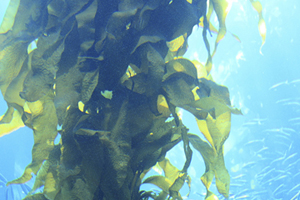Seaweed: A new option for immune stimulation

Animal producers of today are concerned with vaccination. It is an essential technique for the protection of the livestock health which, however, entails significant costs for stock breeders. Maximising the efficiency and effectiveness of prophylactic ?vaccination strategies is therefore a major stake.
Dr H. Demais at BioVet Conseil, Dr P. Nyvall Collen and Amadéite technical team, Amadéite, France
To achieve high efficiency, new avenues are constantly explored. One of them concerns the use of new molecules extracted from seaweeds to stimulate the natural defences of the body and its response to vaccination strategies. There are two types of immunity on which body’s response to the aggression of a pathogen is based: innate immune response and adaptive response ( Figure 1 ).
Innate immunity
The innate response is the first line of defence against pathogens. It is
activated immediately and acts very quickly. This immune response can be found in all animals. It will be the same whenever the body encounters that pathogen. However, the body does not retain a memory of the infectious agent. The mechanism of this type of immunity consists in recognising the molecular patterns shared by numerous pathogens, which are essentially represented by membrane fractions (glycocalyx).
The various elements that contribute to the innate immune response are the following:
•Physical barrier (mucous membrane, skin, mucus, villi etc)
•Phagocytic cells, such as the macrophages
• Natural killer (NK) cells, i.e. large granular lymphocytes
• Certain cytokines, which deliver signals warning the body of a danger
• Complement system
•Toll-Like Receptors (TLR), a family of membrane receptors only recently discovered. They control the expression of molecules that fight against infectious agents (directly or indirectly, via effector cells, and by recruiting the activation of the adaptive immune system).
The elements associated with the innate immune response can act on the pathogen directly or indirectly, by producing effector cells (cytokines etc). The latter will subsequently trigger the adaptive immunity by activating the T and B cells, which are small lymphocytes.
Adaptive immunity
Unlike the innate response, the Acquired or Adaptive response occurs in vertebrates only. During the first encounter with a given pathogen (primary infection), it acts as the body’s second line of defence. Its activation takes then some time – known as latency takes some time.
However, this response system memorises the pathogens it encounters and when the body is again exposed to them the latency is much shorter and the immune system reacts to the aggression almost immediately. Adaptive immunity is specific: it recognises the molecular patterns of the already encountered pathogens.
There are various elements that contribute to the adaptive immune response:
• T cells
• B cells
• Antibodies
• Immunoglobulin (Ig), T cell receptor (TCR), Cytotoxic T cell (CTL), antibody (AB) producing plasma cells + coupled aid of the innate immunity effectors
A new source of active elements
In recent years the relevance of seaweeds in numerous biological applications was brought to the forefront,
particularly to immune mechanisms, taking special interest sulfated polysaccharides. These are complex carbohydrates which do not occur in terrestrial plants. They are supposed to influence the immune system by a vast number inadequately understood pathways.
Sulfated polysaccharides
Polysaccharides represent a structurally diverse class of macromolecules which are relatively widespread in nature. There are simple and complex forms of polysachharides.
Unlike proteins and nucleic acids, polysaccharides contain repetitive structural features which are chains of monosaccharide residues joined together by glycosidic bonds.
They form polymer (-type) structures represented in the form of chains that may be homogenous (homopolysaccharides) or not (heteropolysaccharides). The simple forms are the homopolysaccharides composed of a single type of sugar, linked in an essentially linear manner (starch,
glycogen, cellulose etc).
They are structural compounds or mechanisms of energy storage in an easily releasable form. Their structure may become more complex owing to their capacity of establishing links at various levels of each elementary unit, allowing thus the development of branching structures in the three dimensions. Figure 2 illustrates the branched heteropolysaccharides.
Structural variability
The nucleotides in nucleic acids and the amino acids in proteins can interconnect in only one way, while the monosaccharide units in oligosaccharides and polysaccharides can interconnect at several points to form a wide variety of linear or branched structures.
For instance, the number of possible permutations for four different sugar monomers can attain up to 35,560 unique tetrasaccharides, while four amino acids can form only 24 different permutations.
This explains the fact that, among macromolecules, polysaccharides provide the highest capacity for carrying biological information, as they have the greatest potential for structural variability. In addition, one of the attributes that numerous marine polysaccharides possess is their polyanionic character, which confers them a high chemical reactivity.
Of these anionic polysaccharides, the majority of those which occur in seaweed are sulfated polysaccharides: galactan (agar, carrageenan), ulvans and fucans.
The ulvans, the water-soluble polysaccharides found in green seaweed of the order Ulvales (Ulva and Enteromorpha), have sulfate, rhamnose, xylose, iduronic and glucuronic acids as their main constituents. Ulvan structure shows great complexity and variability as evidenced by the numerous oligosaccharide repeating structural patterns identified. The main repeating disaccharide units reported are of ulvanobiouronic acid 3-sulfate type, containing either glucuronic or iduronic acid. In addition, a few repeating patterns can be found that contain sulfated xylose replacing uronic acid or glucuronic acid on the O2 binding/link of the rhamnose-3-sulfate units.
Interests
This huge variability in the polysaccharide structure provides the flexibility required for exact regulatory mechanisms in different cell-cell interactions in higher organisms.
Sulfation in particular seems to be conducive to various biological activities noted in polysaccharides extracted from seaweed.
Marine sulfated polysaccharides: Role and effect on immunity
Sulfated polysaccharides, which are widespread in seaweed, have been observed to possess anti-infectious (anti-viral, anti-bacterial, anti-tumoral), antioxidant and anti-thrombotic activities.
They also act as immune modulating, stimulating the immune response or in controlling the activity of immune cells in order to mitigate negative effects such as inflammation. One of the pathways of marine sulfated polysaccharides, which has been emphasised recently, is their role in the activation of TLR.
Studies are demonstrating that marine algal polysaccharides can influence the innate immune response by binding to recognition receptors called PRR (Pattern Recognition Receptors), such as the mannose receptors or TLRs of phagocytic cells, especially macrophages. TLRs are transmembrane proteins which detect invading pathogens by binding to ancestral molecules of microbial origin called Pathogen-Associated Molecular Patterns (PAMPs).
The PAMPs contact at TLR level triggers a cascade of responses resulting in the expression of inflammatory response genes. In mammals, these recently identified receptors are numbered from 1 to 11 (TLR1-TLR11). On contact with their respective PAMPs, TLRs specifically activate a signaling pathway consequently NF-kB (Nuclear Factor-kappa B) and AP1 (ActivatorProtein 1) transcription factors regulating the expression of inflammatory cytokines such as TNFα, IL-1 or IL-6.
It appears that TLR plays a key role in the adaptive immune response, however the signals also lead to the activation of numerous other cells and functions of the immune system, which makes them essential both for the innate immune mechanisms and for adaptive immunity.
The activity of some sulfated algal polysaccharides as TLR activating agents might be the result of a certain structural similarity between these marine polysaccharides and bacterial lipopolysaccharides (LPS). Bacterial LPS are a type of structure occurring at the surface of their external membrane and recognised as bacteria-specific elements. Bacterial LPS in mammals are shown to be specifically recognised by TLR4.
Applications in animal health
Seaweeds appear to contain sugars in the form of polysaccharides, some of which – sulfated polysaccharides – are complex polyanionic structures which possess various biological properties. A vast number of studies have already evidenced the effects of some of these sulfated polysaccharides, particularly the fucoidans, the carrageenan and the ulvans, on certain mechanisms of inflammatory response and on
immunity.
The identification and selection of these polysaccharides extracted from suitable seaweeds makes it possible to envisage the use of these molecules as agents for the stimulation of the various mechanisms associated with the body defence and, in particular, of the innate immunity mechanisms.
Within the framework of the potential applications in the fields of animal breeding and animal health, two non-exclusive strategies can be proposed:
1) Regular sequential intakes for a general stimulation of the body’s state of defence:
With a regular intake not connected with vaccination, they allow the body strengthening its defence. Repeated use stimulates ‘basic’ immune system and the boosts the defence condition of the innate system. The use of polysaccharides upstream or downstram of a prophylactic programme may be an asset in enhancing the level of immune protection of an individual or group of livestock and in contributing to a better control of the infectious pressure on the livestock. This prevents the appearance of recurrent infectious pathologies.
2) Targeted intakes within the framework of a vaccination programme:
This can enhance the the intake and persistence of the vaccine and also improve the technical and economic performance of vaccine prophylactic programmes.
Further inquiry can be addressed at: contact@amadeite.com
AAF Volume 21, Issue 5
Join 26,000+ subscribers
Subscribe to our newsletter to stay updated about all the need-to-know content in the feed sector, three times a week. Beheer
Beheer









 WP Admin
WP Admin  Bewerk bericht
Bewerk bericht